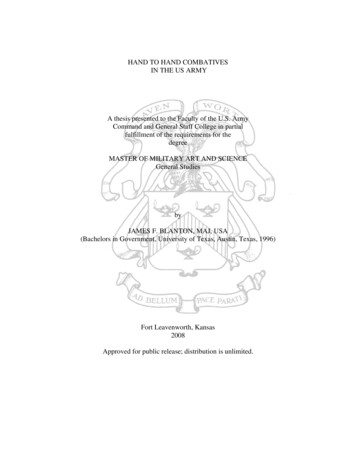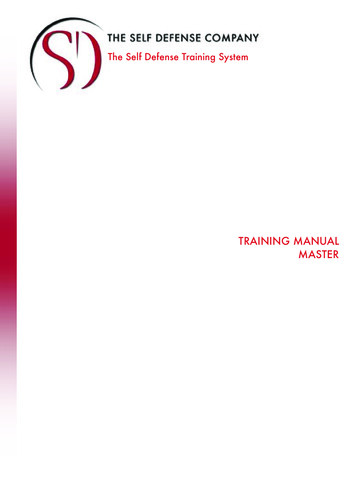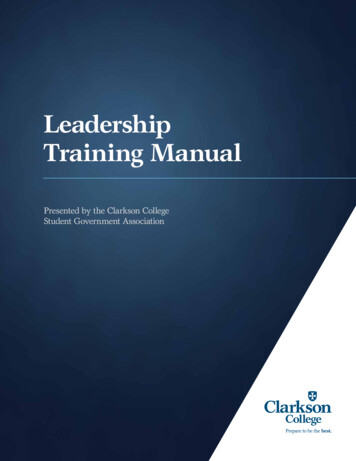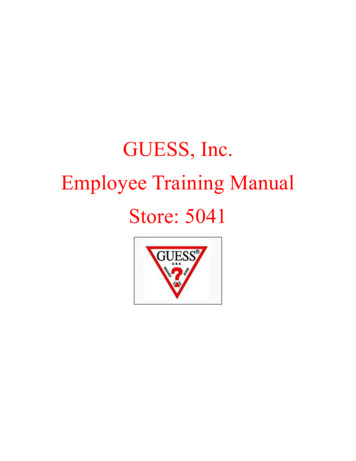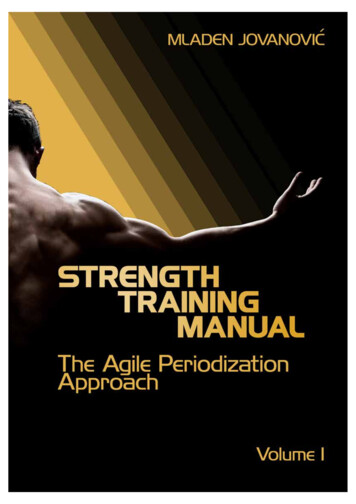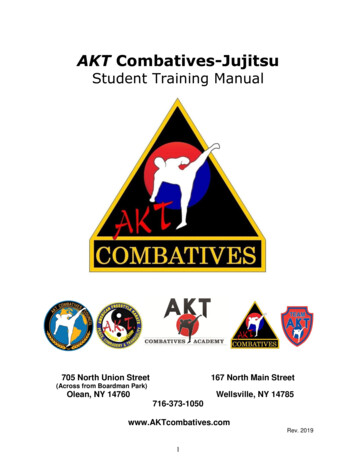
Transcription
AKT Combatives-JujitsuStudent Training Manual705 North Union Street167 North Main Street(Across from Boardman Park)Olean, NY 14760Wellsville, NY 14785716-373-1050www.AKTcombatives.comRev. 20191
Your NameDate You Began Studying at AKTCAYour Class Days and TimesYour InstructorYour goals for studying at AKTCADate Tested for Gold BeltDate Tested for High GoldDate Tested for Orange BeltDate Tested for High OrangeDate Tested for Green BeltDate Tested for High GreenDated Tested for Brown BeltDate Tested for High BrownDate Tested for Black Belt 1st degreeDate Tested for Black Belt 2nd degreeDate Tested for Black Belt 3rd degreeDate Tested for Black Belt 4th degreeDate Tested for Black Belt 5th degree2
Welcome to the AKT Family!At AKT Combatives Academy we strive to provide the highest qualityinstruction to those seeking serious training in the martial arts in a fun,exciting, low-stress environment.No matter what your reasons are for beginning classes with us, ourprofessional certified instructors are honored to be assisting you in reachingyour personal goals; whether it is for fitness, self-defense, or just for fun!Each of our classes will challenge you while improving your confidence, selfdiscipline, and focus; and above all, motivate you to reach your fullestpotential in an encouraging atmosphere. As you mature as a martial artistyou will also learn to motivate yourself in obtaining your next level ofgrowth.This Student Manual is provided to give you information about our schoolsand martial art system, as well as guidelines to aid you in your studies andtraining at AKTCA. This manual is intended to supplement your TrainingJournal, not to replace it. Your training journal should be more than just alist of the techniques that are taught to you during class; it should alsoinclude the drills, concepts, ideas, anatomy and application of techniquesthat you learn as well.To fully grow as a martial artist, you will need to set aside time outside ofyour regular classes to practice on your own. Your Instructors are here toprovide you with new techniques and concepts; however you must beresponsible to practice them daily. It is extremely beneficial for you towarm-up and stretch-out on a daily basis; this not only aids in preventinginjuries, but also improves your techniques, your control, and overall health.I look forward to working with you and am excited to have you as part of ourmartial arts family.I hope that we can help you to get a kick out of life!Yours in Peace, Comradery & Tranquility,Barry A. Broughton, PhDCombatives-JujitsuFounder and Grandmaster3
AKT Combatives-JujitsuDeveloped by Grandmaster Barry A. Broughton, AKT Combatives-Jujitsu is amodern comprehensive eclectic reality-based martial art system. AKT CombativesJujitsu not only includes the strikes, kicks, blocks and defense techniques of moststand-up striking martial arts styles, but it also includes joint manipulations, locks,throws, take-downs, ground fighting techniques and submissions as well as modernweapons fighting and weapons defense.While many martial art styles focus onstand-up striking or ground fighting few address all ranges of attack andcircumstances that are taught as part of the comprehensive AKT Combatives-Jujitsusystem. AKT students learn real-life techniques, concepts and anatomy to ensurethat their skills are effective in any situation."In the application of martial tactics; without knowledge, techniques cannot betruly mastered and concepts cannot be understood. Performance withoutmastery produces mere technicians while the lack of understanding stiflesgrowth. AKT Combatives encourages practitioners to reach beyond their ownlimitations and to strive for excellence in all areas of life. The mastery oftechniques and concepts, as well as life is what produces exceptional martialartists."Having Grandmaster Barry Broughton, beganincorporating aspects of grappling and ground defense into his teaching curriculumin 1982 with his first student (Sensei Brad Monroe) after receiving his first BlackBelt in a stand-up striking system. Having joined the US Army the following year,he had the fortunate opportunity to train with practitioners from other martial artssystems such as American Kempo, Tae Kwon Do, SAMBO (Russian Combatives),Jiu-Jitsu, Hapkido, and kickboxing; and also earned additional Black Belts in KunTao Kung-fu and American Combat Jujitsu.During the early 1990’s, the face of martial arts would be forever changed with theemergence of the Ultimate Fighting Championship and “reality-based training”.Ground fighting became popularized and therefore real-life physical assaultschanged, forcing many martial arts instructors to rethink the effectiveness of whatthey were teaching.Master Broughton felt that a more comprehensive approach4
with the ability to go to the ground, and to defend oneself on the ground, yet stillbe able to strike at any range and on any plane was needed.Having practicedorthopedics and sports medicine, Dr. Broughton applied his intimate understandingof kinesiology, orthopedic and musculoskeletal surgical anatomy to his martial artstraining and instruction, to make techniques more effective.In 2007 Broughton’s resulting system was originally recognized as a “branch” ofanother martial arts style as A.K.T. American Freestyle Karate. As AKT evolved inits scope, techniques, concepts and philosophy into a comprehensive system, AKTAmerican Freestyle Karate was chartered as an independent style with theIndependent Martial Arts Federation, recognizing Master Barry Broughton as theFounder and Headmaster.As the system of AKT matured and became its ownstand-alone style, the system name was changed to AKT Combatives and later toAKT Combatives-Jujitsu to reflect its comprehensive curriculum and concepts.The AKT Combatives-Jujitsu system is not a “take the best of each style” approach;the striking style was modified to include pivoting in close-range stances (without“chambering” the non-striking / non-blocking hand) resembling the more naturalflow of boxing type punches with the elbow and knee strikes of Muay Thai. All ofthe joint locks, chokes, throws, take-downs, and ground techniques have beenmodified to fit into a progressive, adaptive style. Understanding that fighting on theground is extremely dangerous against multiple assailants, AKT Combatives-Jujitsuis not strictly a grappling style. The result is a comprehensive system in which thereis a seamless transition in all ranges and planes of attack; giving practitioners thetools needed to defend against any situation.In 2009 Master Broughton met Sensei Phil Rocheleau, a Modern Army CombativesProgram (MACP) instructor who was still on active duty in the US Army at the time.Along with Sensei Sam Fahy, they shared ideas and techniques as they trained inMACP, which blends the striking of boxing and Muay Thai, the takedowns andthrows of wrestling and Judo, the ground fighting of Brazilian Jiu-Jitsu, and theweapons fighting of eskrima and western martial arts.As they trained, theyrecognized many similarities in the techniques of AKT and Modern ArmyCombatives.Embracing a tenet in the AKT Student Creed of “Evolve or becomeirrelevant”, the AKT curriculum was revised to include drills and teaching chains5
similar to that of Modern Army Combatives. Shortly thereafter, Master Broughtonwas invited to attend a KAPAP (Krav Maga) Combatives course with world renownedShihan Avi Nardia (Major, Israeli Defense Force) to become a Level One KAPAP(Krav Maga) Instructor. The knife and gun defense as well as the close-quartersand ground fighting of KAPAP reaffirmed the techniques and concepts taught in theAKT Combatives curriculum.With Broughton testing for 10th Degree Black Belt and being honored with the titleof Soke (Founder) and Grandmaster of AKT Combatives-Jujitsu by the USA MartialArts Alliance; being recognized by the International Council of Grandmasters, theWorld Wide Martial Arts Council, the American Jujitsu League, and Jujitsu America;by producing several National and World Jujitsu Champions; and by being inductedinto several martial arts Halls of Fame, the system of AKT Combatives Jujitsu hassecured its place in martial arts history.6
Why the name- AKT (American Karate Tactics) Combatives-Jujitsu?AMERICAN – The American idea of “use what works” means not being bound bycultural traditions, especially if they are not effective. Although Asian values havebeen popularized by the martial arts, traditional American values also include thosesame values of: honor, hard work, integrity, loyalty, respect, and serving a greatercause than one-self. Many countries have their own self-defense systems that areinfluenced by the culture in which they were developed. AKT Combatives-Jujitsu ismartial art style developed in America by an American.KARATE – A term derived from two Japanese words, “kara” and “te” meaning“empty hand”. This term is usually understood by most people as an empty handmartial art.TACTICS – A procedure to achieve an end.It implies strategy and precision,especially in combat.COMBATIVES - Synonymous with close-quarters hand-to-hand combat.JUJITSU – Translated as gentle, pliable or yielding art. Jujutsu (Jujitsu) wasdeveloped in feudal Japan as a method of defeating armed and armored opponents.Because striking against armored adversaries is ineffective, practitioners developedmore efficient methods of neutralizing an assailant with joint locks, throws, andpins.AKT (is an intentional pun for Act) – To take action. “Action (AKTion) is faster thanreaction”.The goal of AKT Combatives-Jujitsu is to provide the most comprehensive systemavailable by offering students the concepts and defense techniques relevant totoday’s culture while maintaining the values of traditional martial arts.“The specific self-defense techniques in a particular martial art system arejust the physical manifestation of the systems concepts, philosophies, andvalues. A system that is defined by a finite number of physical techniquesthat does not evolve with the societal changes in which they will be used willbecome irrelevant. Therefore, to remain relevant and effective in the 21stCentury, AKT Combatives-Jujitsu is a ‘reality-based’ system that will evolveover time.” Grandmaster Barry Broughton7
Student CreedTake ground in all aspects of your lifeAction before reactionKnowing that you don’t know is the first stepto true wisdomEvolve or become irrelevantGrowth through struggle is nature’s wayRespect brings peace, comradery and tranquilityOvercoming obstacles is a choiceUnderstanding conceptually brings ease in masteryNurture the desire for continuous self improvementDiscipline begins in the mind AKT Combatives 20108
PledgeAs a martial artist and student of AKT, I represent andsupport not only myself, but my Dojo, my Instructors andfellow Martial Artists. I will live by the traits of honor,integrity, and justice and practice self-discipline to avoidanything that diminishes my mental growth, physicalhealth, or caliber of my character.I will do my best in all things and encourage others todo the same. I will never be a bully or be abusive. I willvalue and protect the loyalty and trust that I share withmy instructors and fellow AKT practitioners.I pledge to be a life-long learner and continue to seekknowledge as a warrior-scholar. I will use what I havelearned only for self-defense or the defense of thoseunable to defend themselves.I will demonstraterestraint and have the courage to live my life as aPeaceful Warrior.I will strive to embody the tenets of the AKT StudentCreed in all aspects of my life.I am AKT and I will TAKE GROUND! AKT Combatives 20149
10
Basic TermsSensei-Instructor (Japanese origins)Dojo-Martial arts school (Japanese origins)Karate-Empty hand (martial arts of Japanese origins)Combatives- Refers to modern close-quarters hand-to-hand combatJujitsu-Gentle, pliable or yielding artHoung Tai- AttentionHa Jime- BeginMah Tai- StopGi- Martial Arts Uniform11
Dojo Guidelines1. Be respectful of the dojo, fellow students, instructors, visitors and yourself.2. Let your Instructor know of any injuries inside or outside of class.3. Keep your own journal of all techniques, drills, concepts and katas taught to you.4. After you have changed into your gi, store all clothes and gym bags in the cubbiesprovided in the changing area. Do not throw your clothes on the floor or keep themhanging in the changing stalls.5. Anything lost or stolen is not the responsibility of the academy.6. No wearing of socks or shoes on the training floor, with the exception of martialarts footwear or wrestling shoes with the approval of the instructor.7. No chewing gum, food or drink on the training floor (with the exception of water).8. For the safety of yourself and your training partners, No jewelry is to be worn during class,exception of wedding bands. If body piercings cannot be removed they must be tapeddown.9. Always bow upon entering and leaving the training floor. See “Formality of the Bow” onnext page.10. When “Fall in” is called at the beginning of class, assume the position of attention information with the highest-ranking student at the front left of the class and the lowestranking student in the back right.11. No talking without permission and no fidgeting while in formal formation.12. No profanity or inappropriate language at anytime.13. If you have any questions about specific techniques or during the individual study timeof class ask a student of higher rank or a Disciple. If they are unable answer yourquestion, both (all) need to ask the instructor.14. The training floor must be clean and organized at all times. All training equipment mustbe returned to designated areas after use. Dry off the equipment and/or floor if it issoiled after use. Senior students should ensure the floor is swept after each class.15. Full Gi must be worn during class (approved t-shirts allowed at Instructor’s discretion).16. If you need to adjust your gi or belt, you need to face away from head wall and/ orinstructor before doing so.12
17. Never leave training floor without permission (unless it is an emergency).18. Never interrupt students working alone, if you wish to ask them a question, or workwith another student stand in a rest position until recognized (no bows will beexchanged).19. If you are late to class: A) Get dressed in full gi. B) Wait at main entrance of trainingfloor until given permission by Instructor to enter. C) Upon entering the training floorbow to flag and all Black Belts. D) If permission is given to leave class early, reverse theabove process.20. If you must speak to the Instructor while they are working with someone else;approach and stand in a rest position, wait to be recognized, bow to the Sensei orMaster, ask your question, bow again when finished.21. If a known Black Belt enters the dojo during class (excluding fitness classes), stop allactivity, call class to Houng Tai (attention), greet the entering Black Belt with a bow,then resume activity.22. Testing - Promotions are awarded to those who complete the required course of studyand successfully complete and pass a test for promotion. Full gi must be worn for alltests and promotions.23. For Safety issues (and Personal Hygiene) please avoid the use of Alcohol prior to attendingclass. Be responsible and use common sense!13
The Formality of The BowThere are three primary occasions for bowing. The first is a series ofbows regularly at the beginning and end of a class in a formal setting.The second and third have specific applications.1. Bowing in (and out) at the Beginning and End of class:Bow when entering or leaving the dojo/building.Another bow is executed as you enter and leave the formal trainingfloor.If there is an American flag or others representing the style thestudent approaches them and executes a bow of respect, with a singlebow being all inclusive.The next bow is when the instructor (regardless of rank) calls theclass to order with the ceremonial bow being executed betweeninstructor and students each to the other. Another inclusiveceremonial bow is executed by the entire class and the instructor(s)towards the American Flag and/or banners.If one leaves the floor for a break or other reason and will return tothe training area, a bow at the gate or door upon leaving and reentering is all that is necessary.2. Bowing During class or a formal training session:If a student is approached by a Black Belt, the student should cometo a rest position and immediately execute a bow. He/She thenremains in the rest position until instructed otherwise by the BlackBelt. Always allow enough time so that the Black Belt rises firstduring the bow. According to tradition, rising before the Black Beltputs him/her in an involuntary position of vulnerability and isconsidered very disrespectful and should not occur.3. Recognizing a Black Belt entering while class is in session:If someone enters the dojo in plain view of the training floor and isrecognized as a Black Belt, regardless of style or system, the firstperson to see and recognize as such should call the class to order bycalling “Houng Tai” and all should face toward the person entering. Ifappropriate, the instructor will call “Bow” and a bow of respectwill be executed. The instructor will, at his/her discretion, instructthe class to resume.14
Uniform RequirementsStudent UniformsTraditional style medium or heavy weight karate or jujitsu style gi.Pants may be either draw string waist, elastic waist band or a combination.Kids Juitisu/Karate Club (5-7 year old -½ hour class)- Black top and black pants.Jr. AKT (8- 13 y/o- 1 hr. class)- Blue top/Black pants or Black top/Blue pants.AKT Combatives (Teen/Adult)- Blue top/Black pants or Black top/Blue pants.Grappling Shorts (without pockets) of the appropriate solid color may be wornduring the summer months.Rank belt is a 1¾ inch “double wrap” colored belt. Black 1/4th inch promotion stripsare worn on the left side of the belt, beginning 2 inches from the end and 3/4 inchbetween stripes.Black Belts/InstructorsTraditional style medium weight or heavyweight karate or jujitsu style gi.Pants may be draw string waist, elastic waist band or a combination.Training:AKT Combatives-Jujitsu Black Belts will wear same blue/black top/pantcolor combination as adult students.AKT Combatives-Jujitsu Semi-Formal (Optional):Blue top with 1½” black lapel.Black pants with 1½” blue stripe down outside seam of both pant legs.Rank Belt for Instructors:Black 2 inch “double wrap” belt. Red 1/4th inch degree strips are worn on the leftside of the belt, beginning 2 inches from the end and 1/4 inch between stripes.One stripe 1st degree, 2 stripes 2nd degree, 3 stripes 3rd degree, etc.Master Instructors (5th and 6th degree) have the option of wearing a red andblack blocked belt.Sr. Masters (7th and 8th degree) have the option of wearing a black andwhite blocked belt.Grandmasters (9th and 10th degree) have the option of wearing a red and whiteblocked belt.Black Belts have the option of having their name and/or AKT Jujitsu kanji/katakanaembroidered on their belt in red Japanese Katakana characters or English lettering.The instructor name may be placed on the left side of the belt above the Reddegree stripes, and AKT Jujitsu characters may be placed on the right side of thebelt.15
General Uniform Guidelines:An Academy T-shirt, rash guard or Solid Black T-shirt may be worn under thegi/uniform top. An academy T-shirt may be worn in place of the gi top during somecomponents of training at the instructor’s discretion. The T-shirt is not meant toreplace the traditional gi top.Females are encouraged to wear a light weight black T-shirt, rash guard or blacksports bra type top under their gi top.The AKTCA logo may be printed on the back of the training gi top.Black martial arts footwear or wrestling shoes may be worn at the discretion of theindividual instructor. Specific style of shoe may be determined by the instructor.Instructors are advised to not allow students to wear martial arts shoes duringregular instruction.Do Not wear your belt outside the dojo unless you are in a formal class or trainingsession held outside. You may wear your gi top and pants to and from class,however your belt should not be worn and tied until you enter the dojo. Do notwear your gi top in stores, restaurants, etc. unless it is completely covered by ajacket.Keep your gi neat and clean at all times. Wash your gi between classes. You maywash your belt if it becomes sweaty or dirty during training. Even if you did notpersonally sweat during class, sweat from a fellow student or instructor, or from thetraining floor most likely will be on your gi/uniform. Keeping a dirty gi in your gymbag between classes without washing it provides the perfect medium for growingbacteria and fungus. A clean gi and belt helps to prevent staph and fungalinfections. Teen and Adult students who train on a regular basis are encouraged tohave at least two (2) gi, so as to always have a clean uniform for class.Personal HygieneRemember that you will be training in close proximity to other students, thereforepersonal hygiene is very important. Please use deodorant as needed.Because of certain sensitivities please do not wear perfume or cologne to class.Please avoid the use of tobacco products prior to class.Keep finger nails and toe nails trimmed.Wash Feet before class if you have been wearing sandals, flip-flops or opentoed shoes.Keep all cuts, lacerations or open wounds covered.16
AKT Combatives Student Advancements and PromotionsOftentimes as a martial artist, students will have questions about the timing ofreceiving new techniques and belt promotions. While we understand the concernand desire to keep pace with fellow students, we are also aware that no twostudents will follow the same journey in their martial arts training (even if theystart at the same time). Although there is a minimum time and specific techniquerequirement for each belt, there is much more to learn before a student is ready toadvance.Students train together in a class format, but every student is on their ownindividual path and they receive new techniques and belt promotions when ourinstructors feel that particular student is ready, not based on the progression offellow students, nor on a set time limit. Testing also occurs in different formats fora variety of reasons based on what an AKT Instructor needs to evaluate for aparticular student. We do not charge test fees or belt fees because AKTCombatives-Jujitsu is not about pushing students through a designated set oftechniques in a pre-set amount of time. We focus on developing martial artists wholearn about integrity and respect and service to others. We work diligently todevelop self-confidence and self-empowerment in our students. As our studentstrain together, they learn to work together and to embrace their differences(personally and culturally) in an environment where it is safe to be their individualself. They learn how to overcome obstacles and to Take Ground in all aspects oftheir life. This is not something that is achieved by learning a set number oftechniques or by earning the next belt. It’s achieved by spending time with otherstudents and instructors – martial artists – who demonstrate these traits. Thequalities of a true martial artist are learned through struggle and failure and hardwon achievements, not by an acquired number of techniques or number of monthstraining.In addition, there are many reasons that our students’ progress at an individualpace: Number of classes attended: Students who attend more classes accruemore hours of training and often progress more quickly because of the addedtraining time.17
Extra AKT activities: Participating in Team AKT, Demonstrations, and AKTSeminars and Training Camps accelerates a student’s learning and alsodevelops their ability to perform in public as part of a Team and also as aleader. Understanding of techniques: This means the student is not onlyproficient at executing the technique but that they understand the subtletiesand application of the technique, as well as how that technique can beexecuted in various scenarios. Understanding of concepts: Our AKT Combatives-Jujitsu system is basedon concepts. It’s imperative that a student fully understands the concepts(the why) of techniques and other lessons for each belt before they are readyto advance or be promoted. Some student’s grasp concepts more quicklythan other students. Also, our concepts are deep and multi-layered. Thelonger a student trains the more fully they understand the concepts. Their interaction with fellow AKT students and instructors:oAre they helping other students learn and grow as martial artists?oAre they respectful and helpful to their instructors?oAre they complaining about, or supporting, a class and familyenvironment?oAre they fully engaged in class and putting in the effort required todevelop their skills? Maturity and development of what it means to be a Martial Artist: Asmentioned above, this is perhaps the most important aspect of AKTCombatives-Jujitsu training, and it is not something that is learned based onthe number of techniques or months a student acquires.To assist in achieving a more thorough understanding of the AKT CombativesJujitsu concepts, as well as some of the foundational physical techniques presentedthroughout your training, Teen and Adult students are highly encouraged to readBeyond Self-Defense: AKT Combatives Realty-Based Personal Protectionwritten by Grandmaster Broughton.18
19
20
Personal Achievement Awards for Kids Jujitsu/Karate21
How to Fold Your GiIf you wash and fold your gi properly you will always look sharp and your giwill last much longer. Never just wad your gi up and throw in your dufflebag. A wrinkle and crumpled gi gives a disheveled appearance and isconsidered disrespectful.The first method is a Square Fold and works best if you’re packing your gineatly along with other gear.The second way is a Rounded Fold and works best if you’re carrying thegi without a training bag but still want it to look neat and professional.Either Fold works just as well. Take your pick and use what works for you.1. Square FoldStep by Step:Instructions1. Put your folded pants overyour open jacket.2. Fold the jacket sides overthe pants, then fold backthe sleeves.3. Fold up the jacket/pantsfrom the bottom twice.4. Tie your belt around thewhole package.5. Put your neatly fold gi inyour training bag.22
How to Fold Your Gi (continued)2. Round FoldStep by Step:Instructions1. Put your folded pants overyour open jacket.2. Fold the jacket sides overthe pants, then fold backthe sleeves.3. Roll up the jacket/pantsfrom the bottom.4. Tie your belt around therolled gi.5. Swing it over your shoulderand head to the dojo!23
How to Tie Your Belt24
25
PROPER STRETCHING TECHNIQUESIt is extremely important that you warm up before doing anystretching. Many sports medicine studies have found cold stretching to becounterproductive to gaining sustainable flexibility. It is safer to do aboutfive minutes of cardiovascular activity that may include, treadmill, stationarybike, jumping jacks, jump rope, light katas, etc at a light to moderateintensity. While performing your stretching activities, attempt to hold yourfeet, hands, and body in a similar position as if you were performing aspecific kick or technique. As you begin your stretching exercises, increasethe range of stretch until you feel a mild tension. Relax and hold the stretchfor 15 to 30 seconds. As you breathe and relax into the stretch position, thefeeling of tension should ease as you hold the stretch. If not, just slowlyease off until it feels more comfortable. After the 15 to 30 seconds, increasethe stretch just a little, until you feel that same mild tension. Again hold for15 to 30 seconds.While stretching, breathe slowly and naturally. Do not hold your breath whilestretching. Keep your muscles relaxed, including your hands, feet, shouldersand jaw.When you stretch too far at to fast of a pace, a nerve reflex signals themuscle to contract. A simple technique to “over-ride” this reflex is calledProprioceptive Neuromuscular Facilitation (PNF). PNF invokes an "inversestretch reflex” upon the muscle spindles and golgi tendon organs (GTO) ofthe muscles you are attempting to lengthen. PNF is one of the best methodsto increase overall flexibility in targeted muscle groups.As in conventional stretching, stretch to a range where you feel mildtension. At this point, isometrically contract the muscle against the supportholding your extremity. In other words, push down against a rail, countertop, or training partner for a period of about six seconds; then relax forabout six seconds. You will find that you now can easily increase yourstretch further than your previous repetition. Do so until you feel mildtension again and repeat the isometric contraction up to four times. Usediscretion and listen to your body. Do not tolerate anything resembling pain.Pain is a signal that something is wrong. Stop the activityimmediately and assess the painful area. The old adage of, "No pain,no gain" is absolutely inappropriate to stretching activities.26
Additional Requirements for Earning a Black Belt inAKT Combatives JujitsuBecause the Mission Statement of AKT Combatives Jujitsu states that we aredeveloping Warrior-Scholars, Lifelong Learners and World Leaders, there are severaladditional requirements that must be completed prior to testing for a (full/adult) BlackBelt at any AKT Combatives Academy.In addition to the physical techniques that are required from High Brown Belt to BlackBelt, the following tasks must be completed prior to testing for Black Belt.1. Obtain and maintain CPR and First Aid Certification.2. Read five (5) of the books on
Student Training Manual 705 North Union Street 167 North Main Street (Across from Boardman Park) Olean, NY 14760 Wellsville, NY 14785 716-373-105
